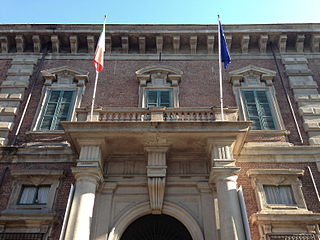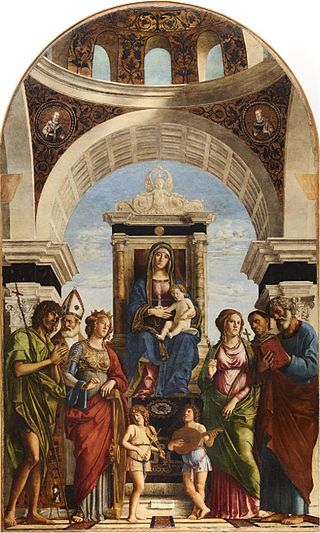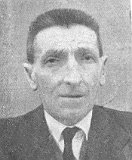
The Gallerie dell'Accademia is a museum gallery of pre-19th-century art in Venice, northern Italy. It is housed in the Scuola della Carità on the south bank of the Grand Canal, within the sestiere of Dorsoduro. It was originally the gallery of the Accademia di Belle Arti di Venezia, the art academy of Venice, from which it became independent in 1879, and for which the Ponte dell'Accademia and the Accademia boat landing station for the vaporetto water bus are named. The two institutions remained in the same building until 2004, when the art school moved to the Ospedale degli Incurabili.

Giovanni Battista Cima, also called Cima da Conegliano, was an Italian Renaissance painter, who mostly worked in Venice. He can be considered part of the Venetian school, though he was also influenced by Antonello da Messina, in the emphasis he gives to landscape backgrounds and the tranquil atmosphere of his works.

Marco Basaiti was a Venetian painter of Albanian origin who worked mainly in Venice during the Renaissance and was a contemporary of Giovanni Bellini and Cima da Conegliano. He has been referred to by several names including Marco Baxaiti, Marcus Basitus, and Marcus Baxiti. There is little documentation on Marco Basaiti besides his painting signatures and a guild's ledger of 1530 that records him as a painter of figures.

Antonio Cavallucci was an eighteenth-century Italian painter of religious scenes and portraits.

Palazzo Brera or Palazzo di Brera is a monumental palace in Milan, in Lombardy in northern Italy. It was a Jesuit college for two hundred years. It now houses several cultural institutions including the Accademia di Brera, the art academy of the city, and its gallery, the Pinacoteca di Brera; the Orto Botanico di Brera, a botanical garden; an observatory, the Osservatorio Astronomico di Brera; the Istituto Lombardo Accademia di Scienze e Lettere, a learned society; and an important library, the Biblioteca di Brera.

Prince Baldassarre Boncompagni-Ludovisi, was an Italian historian of mathematics and aristocrat.

Francesco Manno was an Italian painter and architect of the Neoclassical style.

The National Art Gallery of Bologna is a museum in Bologna, Italy. It is located in the former Saint Ignatius Jesuit novitiate of the city's University district, and inside the same building that houses the Academy of Fine Arts. The museum offers a wide collection of Emilian paintings from the 13th to the 18th century and other fundamental works by artists who were in some way related to the city.

The Accademia Galileiana is a learned society in the city of Padua in Italy. The full name of the society is Accademia galileiana di scienze, lettere ed arti in Padova. It was founded as the Accademia dei Ricovrati in Padua in 1599, on the initiative of a Venetian nobleman, Federico Cornaro. The original members were professors in the University of Padua such as professor Georgios Kalafatis; one of its original members was Galileo Galilei. In 1779 the academy merged with the Accademia di Arte Agraria and became the Accademia di Scienze Lettere e Arti; in 1949 it became the Accademia Patavina di Scienze, Lettere ed Arti; its name was changed to Accademia Galileiana di Scienze, Lettere ed Arti in Padova in 1997, in honor of Galileo. The academy is lodged in the Carraresi Palace in Padua.
Accademia often refers to:

Nicolò Malermi was an Italian biblical scholar credited as the first translator of the Bible from Latin into the Italian language.

The Istituto Veneto di Scienze, Lettere ed Arti (IVSLA) is an academy of sciences in Venice.

The Madonna and Child with Saints Michael the Archangel and Andrea is a Cima da Conegliano painting oil on panel dating from c. 1496–1498, and preserved at the Galleria nazionale di Parma.
Gianfranco Cimmino was an Italian mathematician, working mathematical analysis, numerical analysis, and theory of elliptic partial differential equations: he is known for being the first mathematician generalizing in a weak sense the notion of boundary value in a boundary value problem, and for doing an influential work in numerical analysis.
The following is a timeline of the history of the city of Padua in the Veneto region of Italy.
The Istituto Lombardo Accademia di Scienze e Lettere is an Italian academy founded by Napoleon in 1797. At the time of the foundation the Istituto was an institution of the Cisalpine Republic and its name was Istituto Nazionale della Repubblica Cisalpina.

Giuseppe Suzzi was an Italian mathematician and abbot.

The Conegliano Altarpiece or Madonna and Child with Angels and Saints is an oil painting produced in 1492 by Cima da Conegliano as the high altarpiece for the Duomo di Conegliano in his birthplace.

Piero or Pietro Paolo Vasta was an Italian painter of the Baroque period, mainly active in the east of his native Sicily.

Roberto Cessi was an Italian historian and politician, specializing in Venetian history.
















